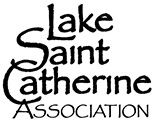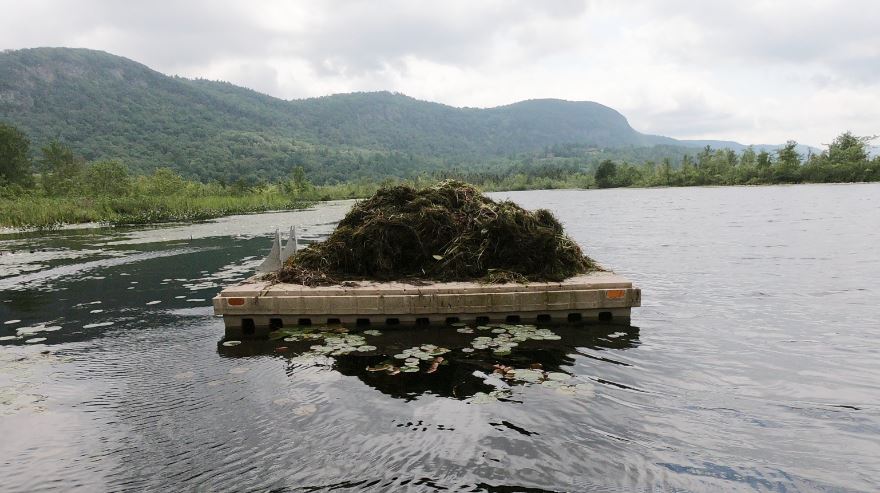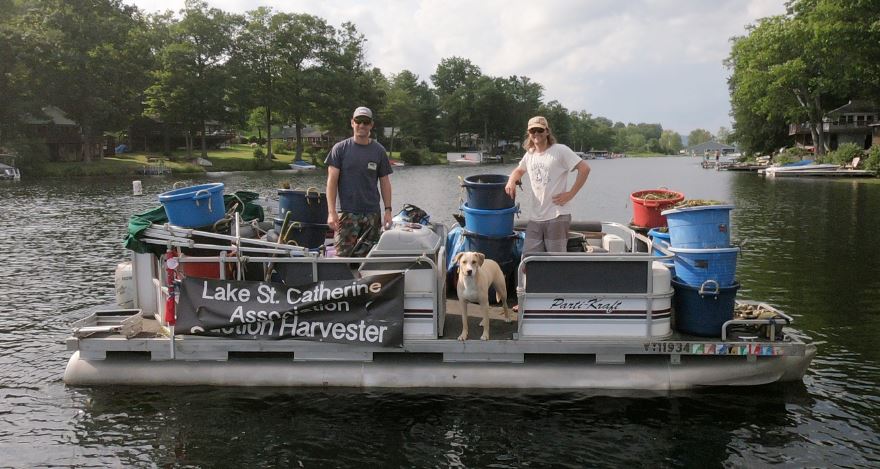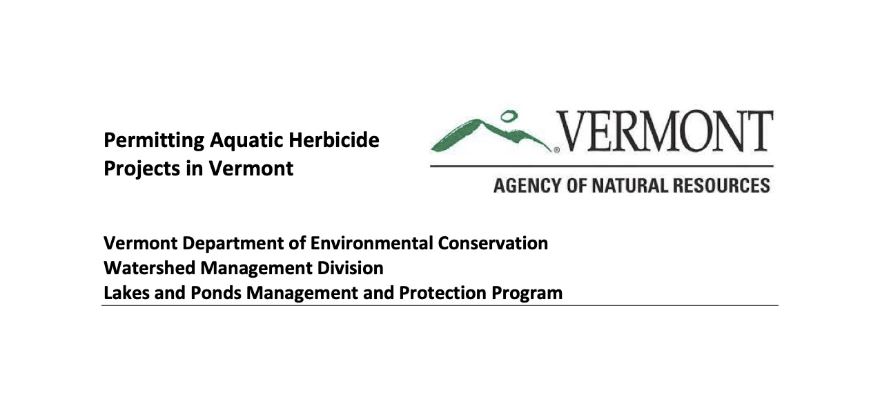For the preservation, protection, and maintenance of Lake St. Catherine |
 |
Milfoil Control on Lake St. Catherine
WHAT IS EURASIAN WATERMILFOIL (EWM, MILFOIL)?
Eurasian watermilfoil is a non-native aquatic plant that is present in most U.S. states and much of Canada. This plant is known for its rapid growth and ability to spread, which can lead to significant problems within a lake. Milfoil forms dense beds that can seriously impair the recreational use of a lake, reduce the availability of fish spawning grounds, outcompete beneficial native plants, and otherwise alter a lake’s natural environment.
The growth and spread of Eurasian watermilfoil is a threat to all our lakes and ponds. Once Eurasian watermilfoil has infested a lake and becomes established, it can be impossible to eradicate it. Lake managers can only seek to control it by integrating the most effective, economically feasible, and environmentally sound methods available.
Of note, Shadow Lake which discovered milfoil plants in 2011, were able to eradicate it after 5 years of intense efforts. Prevention of milfoil introduction to a lake via Greeter Programs and early detection of milfoil plants are critically important to prevent the spread of milfoil. After milfoil was newly discovered in Shadow Lake, their lake association got to work using numerous methods over many years to eradicate their small population of milfoil before it became established and spread throughout the lake.
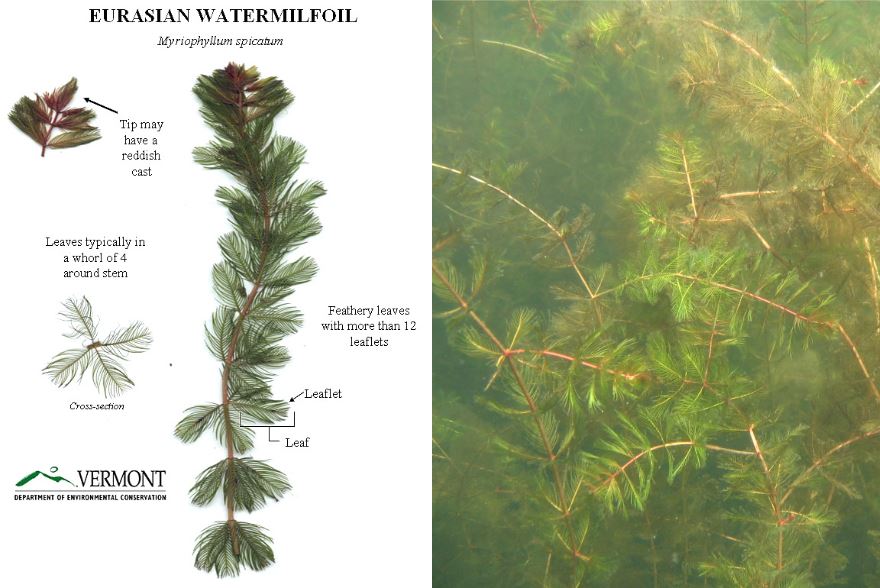
Milfoil was introduced into Lake St. Catherine in the early 1970s, and it quickly spread around the lake. With milfoil increasingly becoming an issue, in 1979, the LSCA purchased a mechanical harvesting machine (many lake old-timers will remember “Hungry Harvey”). However, after many years of using multiple mechanical harvesting machines, it was determined that the harvesters were not providing milfoil control, and they were actually contributing to its spread around the lake. Mechanical harvesting creates milfoil plant fragmentation, and these floaters move to other areas, sink to the bottom, and can create new plants. Also, when mechanically harvesting areas containing native plants and milfoil, the milfoil will regrow more quickly, and it will outcompete the native plants to create a milfoil monoculture in that area.
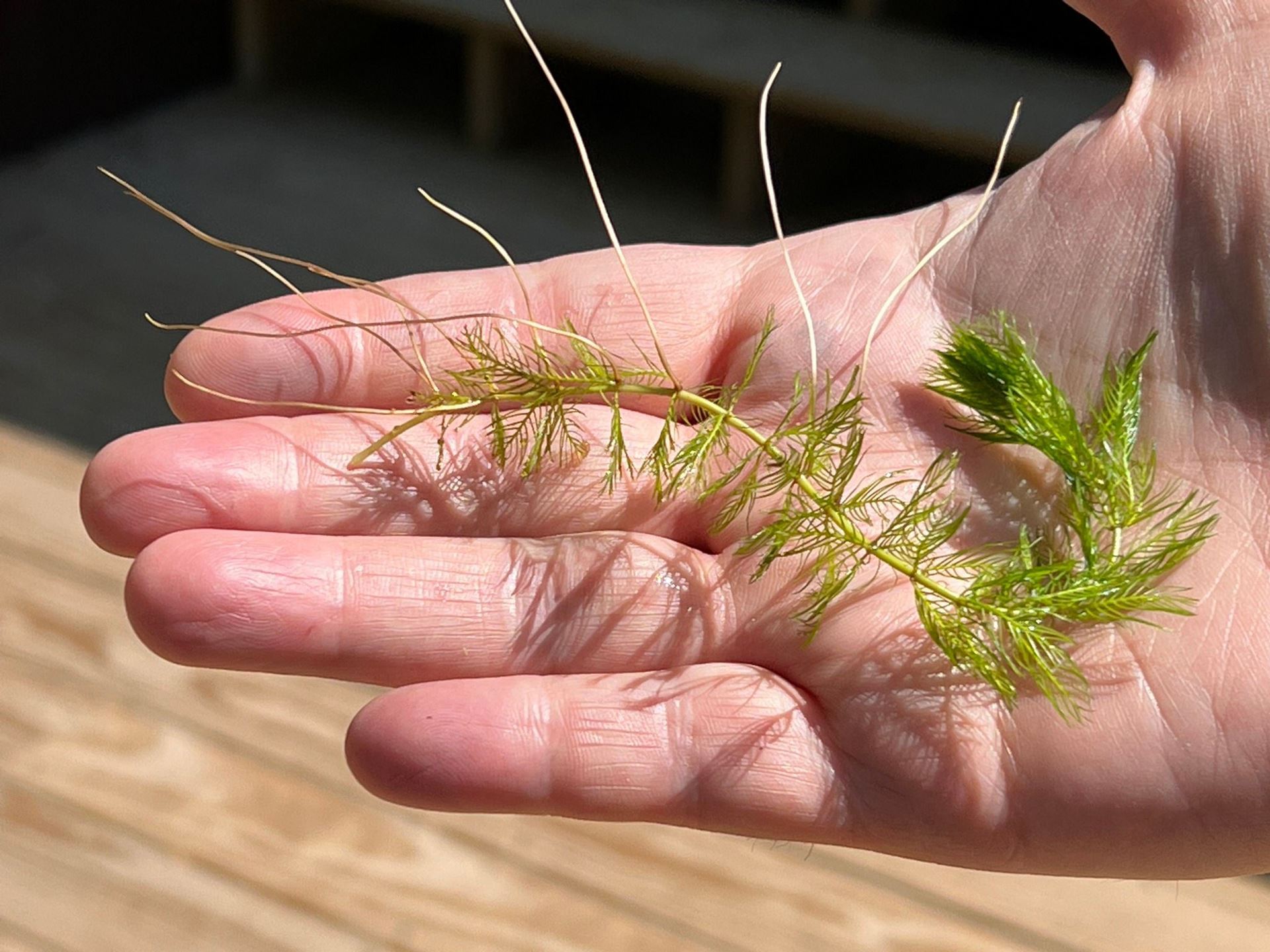
The Vermont Agency of Natural Resources had this to say about mechanical harvesting Eurasian watermilfoil:
"...this method did not provide a satisfactory level of control and may have contributed to its spread via fragmentation. Experience with mechanical harvesting on Rutland County lakes in the 1980’s and 1990’s showed that harvesting resulted in dense beds of EWM since the aggressive plant is quickest to regrow after cutting."
- Permit Response #2014-C01
Because mechanical harvesting was not providing control, and actually contributing to its spread, the LSCA stopped mechanically harvesting milfoil in 2003, and continued to investigate alternatives.
WHAT IS THE IMPACT OF MILFOIL ON THE LAKE?
Eurasian watermilfoil is not native to North America but originates from Europe, Asia and northern Africa. As an aquatic invasive species (AIS) to this continent, Eurasian watermilfoil has no natural controls (insects, bacteria, fungi) to keep its growth in check. Milfoil stems can reach the surface in up to 20 feet of water, growing up from the lake bottom each year from a fibrous root system. Milfoil grows and spreads extremely quickly, forming dense surface mats. Eurasian watermilfoil will grow readily in many types of lakes, as well as on almost any lake bottom type: silty, sandy, or rocky.
The presence of Eurasian watermilfoil often brings a change in the natural lake environment. Over time, it outcompetes and suppresses the more beneficial native aquatic plants, severely reducing natural plant diversity within a lake. Since its growth is typically dense, milfoil weed beds are poor spawning areas for fish. Although many aquatic plants serve as valuable food sources for wildlife, waterfowl, fish, and insects, Eurasian watermilfoil is rarely used for food. Dense surface mats of milfoil can also impede recreational activities like fishing, boating, kayaking, and swimming.
Eurasian watermilfoil reproduces almost exclusively by the breaking off of fragments which can drift away, sink, develop roots, and grow into plants. A fragment just a few inches long is capable of starting a new plant. This fragmentation occurs both naturally and as a result of human activity. Within a lake, wind and waves may break plants loose, allowing them to drift into new locations and root. Boating activity through dense milfoil beds also contributes to the fragmenting and spread of milfoil plants.
From USGS.gov:
“Eurasian watermilfoil competes aggressively to displace and reduce the diversity of native aquatic plants. It elongates from shoots initiated in the fall, beginning spring growth earlier than other aquatic plants. Tolerant of low water temperatures, it quickly grows to the surface, forming dense canopies that overtop and shade the surrounding vegetation (Madsen et al. 1991). Canopy formation and light reduction, are significant factors in the decline of native plant abundance and diversity observed when Eurasian water-milfoil invades healthy plant communities (Smith and Barko 1990; Madsen 1994).”
From the Lake Champlain Basin Program (LCBP), milfoil can:
- Decrease native plant diversity by out-competing native aquatic plants
- Decrease light penetration, habitat complexity and oxygenation
- Increase sedimentation, nutrient loading, and accelerate eutrophication
- Affect PH and temperature levels
When milfoil was introduced into Lake St. Catherine, it quickly spread throughout the littoral zone of the lake (the area of the lake that supports rooted aquatic vegetation), out-competing our native plants, and impacting the health of the lake.
Here is an image from Little Lake taken in early June of 2021. Because of its shallow depth, the whole of Little Lake is a littoral zone. You can see how dense the milfoil can grow, and how it had taken over Little Lake:
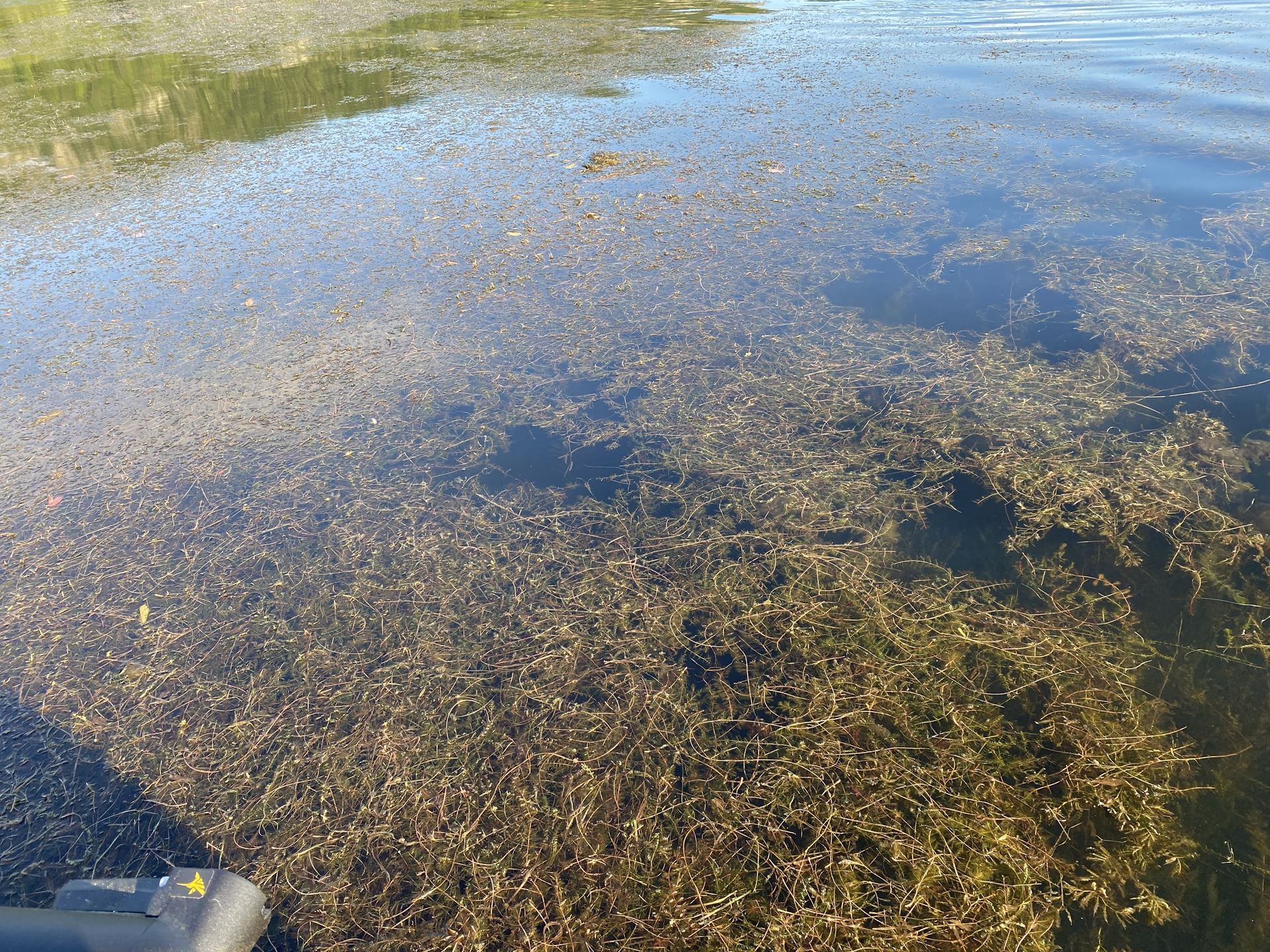
WHAT DOES THE LSCA DO TO CONTROL MILFOIL?
The LSCA’s Milfoil Control Program consists of five components:
1. ‘Stop The Spread’ education and outreach. Our ‘Stop The Spread’ campaign educates boaters and property owners on best practices to limit the spread of milfoil. Each year, the LSCA holds a lake community meeting to discuss the control plan for the season, answer questions, and hand out a flyer with best practices for lake users to limit the spread of milfoil.

2. Volunteer milfoil cleanup. Throughout the season, we encourage lake users, boaters, and volunteers to collect detached floating milfoil and remove it from the lake, along with encouraging property owners to remove detached milfoil, and hand-pulling any along their shoreline.
3. DASH - Diver Assisted Suction Harvesting. Our DASH crew suits up in scuba gear and hand-pulls milfoil by the roots from the lakebed. In sections of lower milfoil density, they will swim the area and hand-pull with mesh bags. In higher density areas, they will set up the DASH equipment which allows them to suction the hand-pulled milfoil up through a tube to a catch table on a boat. Milfoil is then placed in 17.5 gallon buckets for transport off the lake.
Video of our DASH team working underwater:
4. Herbicide spot treatments with ProcellaCOR EC. In order to maximize our DASH crew’s time, effectiveness, and number of acres covered, one of our control methods includes spot treatments with the herbicide ProcellaCOR EC. We’ll further discuss ProcellaCOR later in on this page. When the lake is spot treated by herbicide, the State recommends that the lake not be used for any purpose on the day of the treatment. Normal recreational and domestic (household) lake water use may resume the next day after treatment, and use of lake water for irrigation may resume 1 week after the treatment. There will not be a spot treatment in 2025.
5. Water quality improvement programs. Although not directly related to Milfoil Control, the LSCA's work on Lake Wise on LSC, the LSC Stormwater Master Plan, and the LSC Watershed Action Plan all help to limit phosphorus and other nutrients from entering the lake which can contribute to excessive plant growth, and improves overall water quality.
These efforts have resulted in the lowest percentage of milfoil cover and frequency of occurrence in the lake since the mid-2000s. Also, and just as importantly, we have seen many species of our native aquatic plants that have been suppressed by milfoil growth like Water stargrass, Tape grass, Thin-leaf pondweed, Illinois pondweed, Common waterweed, and Robbins’ pondweed have all increased in frequency of occurrence, along with an increase in our plant species richness (the number of different plant species present in an ecological community). You can view our Aquatic Vegetation Management Reports dating back to 2001 here.
WHAT HAVE BEEN THE RESULTS OF THE PROGRAM?
Recently, the LSCA has worked with Arrowwood Environmental which has conducted aquatic plant surveys throughout the littoral zone in 2023 and 2024. These surveys are conducted yearly as part of the LSCA’s Milfoil Control Program to monitor native plant species, and map locations of EWM. In the year 2023, Arrowwood described 3 distinct native aquatic natural communities, or assemblages, containing over 35 native plant species:

Lake St. Catherine was found to have an excellent diversity of plants, which creates quality habitat, able to support excellent fish, amphibian, and invertebrate populations and diversity. The Robbins-Illinois Pondweed Assemblage comprises over 70% of the vegetated littoral zone, and these are the areas that provide most of the habitat for aquatic life, including a wide array of benthic organisms and fish in most stages of their life cycles.
Based on aquatic plant survey data dating back to 2001, the Vermont DEC performed an analysis of aquatic plant species richness (SR) and frequency of occurrence (FOC) in Lake St. Catherine. This analysis showed an overall increase in native aquatic plant SR and FOC, which coincides with the Vermont DEC’s finding from 2022 when performing a Statewide analysis of aquatic plant populations in ProcellaCOR EC treated lakes.

Graph showing average aquatic vegetation species richness in Lake St. Catherine's basins from 2001-2023. The trend lines included show a positive trend from 2001-2023 in each basin
This plant survey data shows that over time, the aquatic plant habitat has improved as the LSCA has worked to control milfoil using their five component program.
These results are exactly what we want to see!
Lake St. Catherine has over 35 native aquatic plants which are important and necessary to sustain a healthy lake ecology. Our efforts are focused on reducing the amount of milfoil in the lake so that these native aquatic plants can grow as they normally would. Keeping milfoil under control is helping to return the aquatic plant environment to conditions before milfoil was introduced in the 1970s. Because of our milfoil control efforts, we again have a complex and diverse native aquatic plant community.
For example, here is video of our DASH team evaluating the results of a small spot treatment two months after it was performed in Forest House Bay in mid-June of 2022:
As anticipated, no milfoil was observed, and you can see that our native plants like Eelgrass, Illinois pondweed, and Robbins' pondweed are healthy and abundant.
It’s also important to note that our Boat Launch Greeter Program is a crucial part of invasive species prevention. Although we already have milfoil in Lake St. Catherine, other Vermont lakes do not. Our Greeters who are on duty at the Boat Launch in Wells, and the State Park in Poultney, check boats and trailers to make sure they do not have milfoil on them when they leave. They also check boats and trailers entering the lake for other invasive species that are not currently in LSC like zebra mussels, spiny waterflea, asian clams, and water chestnut which are only a lake away.
HOW IS THE LAKE EVALUATED EACH YEAR FOR MILFOIL?
In late September, our lake management contractor (Arrowwood Environmental) performs a comprehensive, multi-day aquatic plant survey. They visit the 199 GPS data points that were set up in 2001 to evaluate the aquatic plants observed at these locations. Using the data collected, and recommendations from our DASH team based on their observations from the season, our team creates a preliminary control plan of areas to be hand-pulled / suction harvested or spot treated with ProcellaCOR.
In January, the LSCA meets with the Vermont DEC to review the work of our Milfoil Control Program for the previous year, and discuss our preliminary plans for the upcoming year. This meeting is also a great opportunity to discuss our other lake and water quality improvement programs with the DEC.
Then, in early May, a one-day spring survey is performed, and the results are compared it to the fall survey. A final plan will then be created and submitted to the DEC for approval. The LSCA will then inform the lake community of our finalized plans for the season with direct mailings, emails, announcement posts on our website and Facebook pages, and with signage around the lake. We will also schedule a meeting for the lake community so we can discuss the plans for the season, present best practices to limit the spread of milfoil, and answer questions.
CAN YOU TELL ME MORE ABOUT PROCELLACOR?
In May of 2022, as part of our Spring 2022 Newsletter, we noted that misinformation was being posted online and in newspaper commentaries related to the Lake Bomoseen Association applying for a permit to use the herbicide ProcellaCOR EC to control Eurasian watermilfoil. ProcellaCOR is the product that we have used as part of our Milfoil Control Program for spot treatments since 2019. As we mentioned then, and has continued to occur, some are even making things up and disparaging Lake St. Catherine, then using these false stories to voice their opposition to the use of ProcellaCOR.
To help combat this misinformation, and to provide fact-based information on ProcellaCOR, the Vermont Department of Environmental Conservation (DEC), Watershed Management Division, Lakes and Ponds Management and Protection Program published a document in October of 2022 entitled “Permitting Aquatic Herbicide Projects in Vermont”.
The Vermont DEC describes that the purpose of this document is to:
1. Provide background information about DEC’s Aquatic Nuisance Control (ANC) permitting program, with a specific focus on aquatic herbicide projects;
2. Identify some of the recent findings related to ProcellaCOR; and
3. Provide a Q&A section on this topic reflecting common questions that DEC receives about our ANC permitting program
The document details Vermont statutes, the permitting application and technical review process, and the departments and agencies involved in the permitting process.
It also discusses key findings on ProcellaCOR EC, including:
- a pre- and post-treatment statistical analysis of the aquatic plant survey data from Vermont treated waterbodies (showing increases in native plants, and decreases in milfoil)
- an Aquatic Toxicity Review memorandum performed by a DEC Environmental Scientist (concluding that "the potential for acute and chronic risks to fish, aquatic invertebrates, amphibians and other aquatic animals is considered low")
- a Macroinvertebrate Survey conducted by the New York DEC (finding that "No significant changes to the macroinvertebrate community assemblage were observed when comparing survey results pre- and post-herbicide treatment.")
- a review of ProcellaCOR’s confidential statement of formulation memorandum performed by a Vermont State Toxicologist from the Vermont Department of Health (concluding: "Based on a review of the confidential statement of formulation, it is reasonable to conclude that human exposure to the inert compounds contained in ProcellaCOR at the concentrations that would result under the conditions proposed by the applicants, is not likely to result in an increase in the level of concern for public health. Thus, the proposed treatment of Lake Bomoseen with ProcellaCOR is expected to result in negligible risk to public health, from both the active and inert compounds in ProcellaCOR.")
- an acknowledgement from the DEC’s Drinking Water & Groundwater Protection Division ("DWGWPD does not have concerns with the use of ProcellaCOR provided the conclusions from VDH have not changed and that treatment concentrations do not exceed 5 PDUs.")
- …and much more.
Finally, the document contains 16 frequently asked questions posed to the DEC about these topics with their answers.
This document can be viewed here: Permitting Aquatic Herbicide Projects in Vermont
Additional inks:
- LSCA Permit Application (submitted 3/20/24)
- Approved Permit (approved 4/21/25)
- Permit Public Comment Response Summary (published 4/21/25)
- SePRO ProcellaCOR® EC Specimen Label
- SePRO ProcellaCOR® EC Safety Data Sheet
As you will read on the specimen label, there are two plants that are native to Lake St. Catherine that can be affected by ProcellaCOR: Watershield and Coontail. Knowing this, efforts and decisions were made to mitigate the impact on these species by working to keep milfoil spot treatments away from populations of these natives. While we have noted a decrease of these natives near spot treatment areas, they have, and continue to rebound. For example, when Lily Pond was spot treated in 2020, Coontail was not seen at the 24 GPS data points there. This does not necessarily mean that it was no longer in Lily Pond - just that it was not found in the late September survey of 2020 at the any of the 24 GPS points. However, Coontail has rebounded and has increased in frequency of occurrence in 2021 and 2022. We will continue to work with the DEC to make sure future treatments limit or do not impact non-target species.
ADDITIONAL PUBLICATIONS
We'd also like to share a additional publications and webpages with you which deal directly with this recent misinformation, while also providing fact-based information about milfoil, milfoil control, ProcellaCOR, and the permitting process. We hope you will give them a few minutes of your time.
1. Vermont DEC Presentation: "ANC Permitting 101"

This presentation goes into great detail about the lengthy and rigorous process lake associations like the LSCA goes through to apply for a permit, what it takes to receive a permit, and what conditions and reporting requirements are included in approved permits. It also discusses the ongoing work that is needed on a yearly basis after the permit is approved.
2. Federation of Vermont Lakes and Ponds Webpage: "Eurasian watermilfoil"
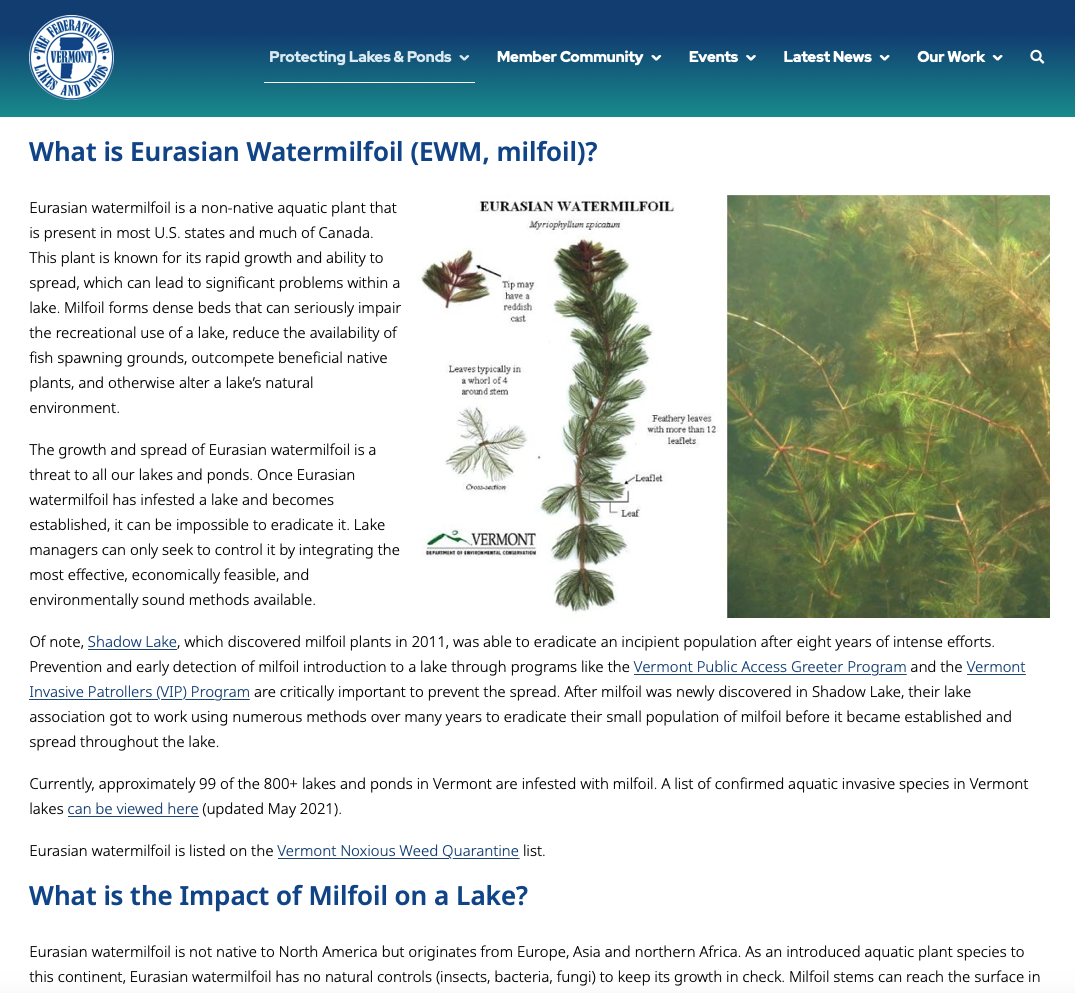
This new webpage from FOVLAP talks about what milfoil is, what it does when it's introduced into a lake, prevention and early detection, control, and an FAQ section which deals directly with recent misinformation on milfoil, ProcellaCOR, and the permitting process you may have come across online or in newspaper commentaries.
3. Federation of Vermont Lakes and Ponds White Paper: "The Case for an Accessible Path for Vermont Lake Associations to Use ProcellaCOR to Control Invasive Milfoil"
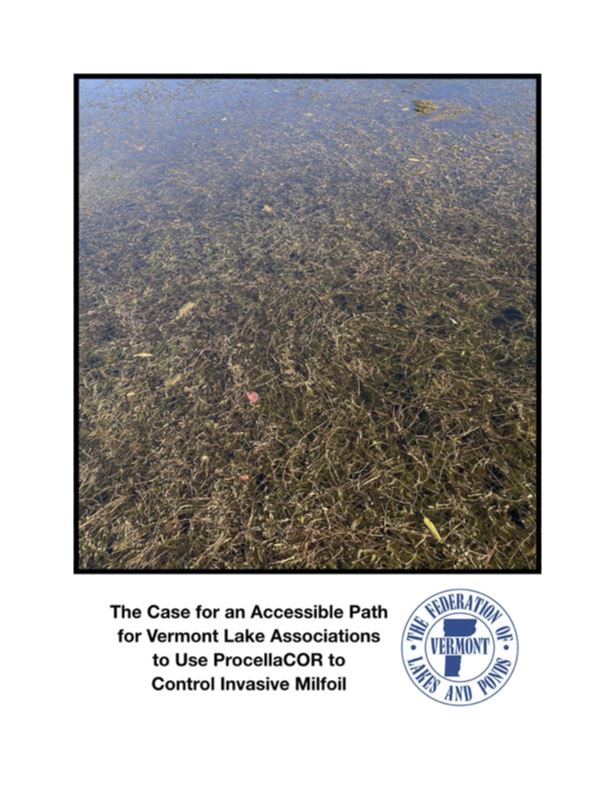
This white paper was submitted to the Act 57 study committee (more on this below). We thank FOVLAP for their work on this document as they make the case that the permitting application and review process remains rigorous but without unjustified new burdens.
4. Act 57 Study Committee Final Report: "Report of the Aquatic Nuisance Control Study Committee"
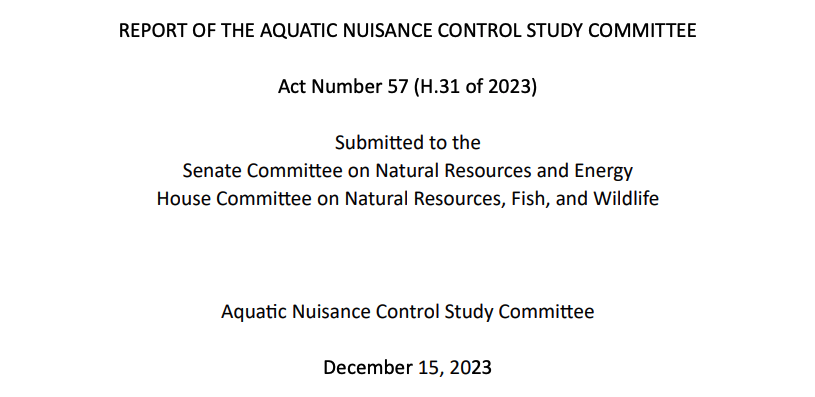
Through the passage of Act No. 57 (H.31 of 2023), an act relating to aquatic nuisance control, the Vermont Legislature established the Aquatic Nuisance Control Study Committee. Act 57 established this Study Committee to assess the environmental and public health effects of the use of pesticides, chemicals other than pesticides, and biological controls for aquatic nuisance control in State waters.
From the Executive Summary: "The Committee summarized the use of aquatic nuisance control pesticides, chemicals other than pesticides, and biological controls and non-chemical controls in Vermont Lakes and Ponds from 2000-2023 to assess their impact on the nontarget environment or nontarget species. The Committee found that the established precautions, standards, internal procedures, and permit conditions outlined in the Aquatic Nuisance Control Permit (10 V.S.A. § 1455) for Pesticides adequately ensure the protection of State waters and are designed to protect fish, reptiles, amphibians, and all other aquatic biota."
Minor recommendations were suggested, including better defining some terms in the statute, increasing community notification, and local municipality involvement.
WHAT CAN YOU DO TO HELP?
First and foremost, your financial support in the form of the yearly dues you contribute to the LSCA are crucial to help fund this program. If you are not currently a member, please consider joining! You can do so easily via our website here: Become A Member, or you can click here to: Make A Donation.
Help to make these efforts a success:
Here are the things that you can do to help stop the spread of milfoil, which are all applicable lake-wide. All require a bit of elbow grease on your part, but if we are all contributing, it can make a big difference around the lake.
- As a general rule, get as much milfoil out of the lake as possible. Let it dry out on land and dispose of it as you would yard waste.
- Don’t drive through milfoil patches with your boat which will create fragments.
- If you have milfoil on your prop, don’t just reverse and drive away, please remove it from the lake.
- If you have milfoil growing in your dock or swimming area, pull it out by the roots and remove it from the lake.
- If you see milfoil floating anywhere in the lake, near your dock, or along your shoreline, remove it from the lake.
- Obey boating regulations by travelling at no-wake, 5 MPH speeds within 200’ of the shoreline.
Keep in mind that native aquatic plants are important and necessary to sustain a healthy lake ecology. Please focus on removing milfoil plants only.
It's up to all of us to stop the spread of milfoil.
IN SUMMARY
The five components of our Milfoil Control Program have been very successful in both keeping the milfoil in check, and in allowing our native aquatic plants to thrive - creating a healthy ecosystem for LSC’s fish and wildlife, and a beautiful lake for all of us to enjoy.
Milfoil Control is just one of the numerous water quality programs the LSCA works on each year. Other programs include: the LSC Stormwater Master Plan, the Lake Wise Program, the LSC Watershed Action Plan, and current and future water testing and measurement programs. These water quality improvement projects are funded by grants earned by the LSCA, allocations from the towns of Wells and Poultney, and your membership contributions and donations.
The LSCA has always employed evidenced-based decision making when evaluating lake related issues, and we continue to do so with our Milfoil Control Program. Working with the State and lake scientists & experts, following the science and the data, and evaluating the results of our efforts show that we are doing the right things for the long-term health of Lake St. Catherine.
To our members, and all who love Lake St. Catherine, if you ever have any questions or concerns, reach out to us. We would be happy to discuss our Milfoil Control Program or any other lake related topic with you so we can address your questions or concerns, and provide you with factual information. Or contact us, and we’ll set up a Dockside Chat, and a LSCA Trustee will swing by your dock for a chat about the lake.
You can always reach us at info@lakestcatherine.org.
EURASIAN WATERMILFOIL FAQ
As we mentioned above, there has been a lot of recent misinformation about milfoil, ProcellaCOR, the permitting process, and Lake St. Catherine in general. What you'll see below is a set of questions and answers addressing this misinformation. This FAQ was compiled by the Federation of Vermont Lakes and Ponds (FOVLAP).
It was previously mentioned that there has been misinformation about the herbicide ProcellaCOR and the Aquatic Nuisance Control (ANC) permitting process. What is this in reference to?
In early 2022, the Lake Bomoseen Association applied for an ANC permit to use ProcellaCOR which resulted in misinformation being spread online and in newspaper commentaries.
To help combat this misinformation, and to provide fact-based information on ProcellaCOR, the Vermont Department of Environmental Conservation (DEC), published a document in October of 2022 entitled "Permitting Aquatic Herbicide Projects in Vermont".
The Vermont DEC describes that the purpose of this document is to:
- Provide background information about DEC's Aquatic Nuisance Control (ANC) permitting program, with a specific focus on aquatic herbicide projects;
- Identify some of the recent findings related to ProcellaCOR; and
- Provide a Q&A section on this topic reflecting common questions that DEC receives about our ANC permitting program
The document details Vermont statutes, the permitting application and technical review process, and the departments and agencies involved in the permitting process.
It also discusses key findings on ProcellaCOR EC, including:
- a pre- and post-treatment statistical analysis of the aquatic plant survey data from Vermont treated waterbodies (showing increases in native plants, and decreases in milfoil)
- an aquatic toxicity review memorandum performed by a Vermont DEC Environmental Scientist (concluding that "the potential for acute and chronic risks to fish, aquatic invertebrates, amphibians and other aquatic animals is considered low")
- a macroinvertebrate survey conducted by New York DEC, finding that "No significant changes to the macroinvertebrate community assemblage were observed when comparing survey results pre- and post-herbicide treatment."
- a review of ProcellaCOR's confidential statement of formulation memorandum, performed by a Vermont State Toxicologist from the Vermont Department of Health concluding: "Based on a review of the confidential statement of formulation, it is reasonable to conclude that human exposure to the inert compounds contained in ProcellaCOR at the concentrations that would result under the conditions proposed by the applicants, is not likely to result in an increase in the level of concern for public health. Thus, the proposed treatment of Lake Bomoseen with ProcellaCOR is expected to result in negligible risk to public health, from both the active and inert compounds in ProcellaCOR.")
- an acknowledgement from the Vermont DEC's Drinking Water & Groundwater Protection Division, "DWGWPD does not have concerns with the use of ProcellaCOR provided the conclusions from VDH have not changed and that treatment concentrations do not exceed 5 PDUs."
Finally, the document contains 16 frequently asked questions posed to the Vermont DEC about these topics with their answers.
This document can be viewed here: Permitting Aquatic Herbicide Projects in Vermont
We also highly recommend reviewing this presentation by the Vermont DEC entitled "ANC Permitting 101" which goes into great detail about the permitting process.
Milfoil has been present in Vermont for over 60 years, hasn't 'Mother Nature' adapted?
Vermont waterbodies have not "adapted" to milfoil, which is why tremendous effort – including at a significant cost – goes into controlling current infestations and preventing new ones. Milfoil has no natural controls to keep it in check as it does in its native regions. The US Department of Agriculture National Invasive Species Information Center lists Eurasian watermilfoil as an invasive species, the Vermont Agency of Agriculture, Food and Markets also designates Eurasian watermilfoil as a Class B Noxious Weed on their Noxious Weeds Quarantine Rule.
We'd encourage you to watch this documentary by the New York DEC: "Uninvited: The Spread of Invasive Species", which you can view on YouTube. While the 53-minute documentary is worth watching in its entirety, if you fast-forward to the 38 minute mark, you'll learn a lot about 'Mother Nature' and invasive species.
The documentary explains that nature cannot take care of itself after the balance is upset, typically a result of human activity. They offer a good example in the documentary of a reed (common reed or Phragmites) that was used as packing material 400 years ago on ships traveling from Europe. The reeds were thrown on shore and took root here in the US. This invasive reed is now destroying native plant species in wetlands, marshes and along lake shores.
In its native land, Phragmites has 170 different insects that feed on it, which keeps it in check, and that ecosystem is in balance. Here in North America, this plant only has five insects that eat it or have adapted to eat it. This imbalance allows common reed to grow uncontrollably, outcompeting native plant species. So, in over 400 years, nature has not adapted. In fact, the speaker says it would take thousands to hundreds of thousands of years for this reed to act like the plants it has displaced.
Unfortunately, we (humans) interfere with 'Mother Nature' all the time by introducing invasive species - knowingly or unknowingly. It is our responsibility to work to control or eradicate invasive species to protect the native species and the ecosystems they have unbalanced.
As was previously mentioned, tremendous cost and effort goes into milfoil control, 99 Vermont lakes are currently infested, and only 1 lake is known to have eradicated it. Isn't all this time, effort, and money wasted since milfoil 'keeps coming back'?
The goal of milfoil management programs is control, not eradication.
Left unchecked, milfoil will spread throughout the littoral zone (the area where light penetrates) of a lake, can form dense beds, and outcompete and suppress native plants, including rare, threatened and endangered species.
Unmanaged milfoil can also:
- Impede recreational activities like fishing, boating, kayaking, and swimming
- Decrease light penetration – limits photosynthesis and can cause algae blooms
- Decrease habitat complexity – reduces species biodiversity and impacts the food web
- Decrease oxygenation – lower oxygen can lead to algae blooms
- Increase sedimentation – a buildup of 'muck' and loss of water depth
- Increase nutrient loading – a release of phosphorus from the sediments causing algae blooms
- Accelerate eutrophication – enriching the lake with nutrients (phosphorus) which can lead to excessive plant and algae growth
- Affect pH and temperature levels – many aquatic organisms have a preferred pH and temperature range
As a perennial invasive aquatic plant, milfoil 'keeps coming back'. Whether an area was cleared of milfoil by hand-pulling, DASH, benthic barriers, or spot treatments of ProcellaCOR, milfoil is prolific, aggressive, and has the ability to grow in a wide range of environmental conditions. Uncontrolled milfoil can lead to fragments that can easily reseed newly controlled areas. By no means does this mean that the time, effort, and cost put into these control efforts is wasted, as the goal of these programs is to keep milfoil at manageable levels so that it's not impacting lake health or recreational use.
A recent newspaper article contained this quote attributed to a university professor with previous work experience at the EPA: "ProcellaCOR is not selective at all. It will not just target the milfoil. It will target indiscriminately every plant in the lake. ProcellaCOR will decimate pretty much all the plants in the treatment areas." Is this true?
Absolutely not. ProcellaCOR is highly selective to milfoil. The specimen label does list a few plants native to Vermont that can be impacted by ProcellaCOR, for example, coontail and watershield. When spot ProcellaCOR treatments are permitted for control milfoil in a lake, permit conditons take into consideration impacts to non-target plants and treatments, e.g., avoiding populations of these sensitive native species, use of low ProcellaCOR concentrations.
Vermont DEC performed a statistical analysis of ProcellaCOR use in Vermont lakes, and this analysis showed statistically significant decreases in milfoil, and statistically significant increases in native plants. These results reflect a successful treament regime - when the invasive plant species is controlled, the native plants will take back that space. This analysis was completed using data from permit-required aquatic plant surveys from Vermont lakes treated with ProcellaCOR.
A recent commentary that appeared in the newspaper written by a university professor with previous work experience at the EPA stated: "...the idea that there is one person in the [Vermont] DEC with sole power to allow or disallow the addition of toxic chemicals into our lakes and streams, is appalling. One person can submit a permit request and another person can grant it? At a minimum, the Vermont Fish and Wildlife Department and the Vermont Department of Environmental Conservation should be in agreement on any pesticide approval." Is it true that one person has the sole power to allow herbicide use, and no other departments are involved?
No, this is a gross distortion of the permitting process. This commentary was written in response to the Lake Bomoseen Association (LBA) submitting a permit application to use ProcellaCOR. All herbicide permit applications go through a rigorous process, involving numerous departments and scientists.
In the specific case of the LBA's application, we have learned from the Vermont DEC that when this application was received, these 15 internal experts, along with additional scientists in the Vermont DEC, reviewed, and provided comments and input on this permit application:
- two scientists from the Vermont Department of Fish and Wildlife (DFW) Wildlife Division
- three scientists from the DFW Fish Division
- the DFW Public Access Area manager
- two DFW staff that oversee the Keho Camp
- two scientists from the Vermont Department of Health
- one scientist from the Vermont DEC Drinking Water Groundwater Protection Division
- the Vermont Department of Forests, Parks and Recreation regional State Parks manager
- two scientists from the Vermont DEC Wetlands Program
- one scientist from the Vermont DEC Monitoring and Assessment Program who is an aquatic toxicologist and member of the Vermont Pesticide Advisory Council
The Vermont DEC and DFW created a framework in 2018 for permitting both herbicide and non-herbicide milfoil control efforts. This framework has been in place since that time, and was used for all ProcellaCOR permits issued, for which both departments determined that all the projects presented an acceptable risk to the non-target environment.
The Vermont DEC also engages the Vermont Department of Health to review submitted pesticide applications to determine if a finding of negligible risk to public health can be made for the pesticide project proposed. In the memorandum for this review, the State Toxicologist determined that the use of ProcellaCOR "...is not likely to result in an increase in the level of concern for public health."
Finally, in late March of 2023, all three departments: Vermont Department of Environmental Conservation, Vermont Department of Fish and Wildlife, and Vermont Department of Health officially formalized the agreed upon framework which you can see here: "Aquatic Nuisance Control (ANC) Individual Permit Application Internal Review Procedure".
For a thorough explanation of the Aquatic Nuisance Control permitting process, see this presentation by the Vermont DEC entitled "ANC Permitting 101".
In recent online postings and newspaper commentaries, statements are made claiming that the Vermont Department of Fish and Wildlife (DFW) had 'weighed in' and opposed the Lake Bomoseen Association's permit application, and that Vermont DEC and the Vermont DFW are in conflict. Is this true?
No. As you can hear in his testimony to the House Committee on Environment and Energy on March 15th, 2023, Lakes and Ponds Program Manager Oliver Pierson dispels the myth that the two departments don't work together, and that the Vermont DFW opposed the Lake Bomoseen permit application:
"This process which we've developed which we call the aquatic nuisance control internal review procedure is unique. I'm not aware of any other examples in our own permit issuing where the authority to issue the permits voluntarily seeks out the input of other State departments who may have slightly different missions and mandates, but we're all in this for similar long-term outcomes and does our best to incorporate those into our permitting decisions. And I think it's worth noting that since we've issued the ProcellaCOR permit on Lake Iroquois, and with all of our ProcellaCOR applications since then, as I've said, we've received input from Fish and Wildlife. With that input, you've established permit conditions you may prohibit certain parts of the lake from being treated because there's rare, threatened, or endangered species. You may say that this part of the lake doesn't need herbicide because they haven't demonstrated that the invasive is interfering with aquatic habitat because we've taken that feedback from our sister department into consideration, and that's influenced our permitting decisions. Most recently, for the Lake Bomoseen permit application, we received feedback from Fish and Wildlife, saying that with a few conditions, such as not treating north of the Grady bridge, and a few other conditions, that as long as we implement those conditions, in the permit, they do not object to this application. Again, I'll let them speak for themselves tomorrow, but I think that is an important point to make that all this division that's being portrayed between DEC and Fish and Wildlife, when you look at the facts, isn't as divisive as it might appear to be. We are really working together to issue these permits in a collaborative manner where their feedback is taken into consideration."
Earlier in his testimony, before this detailed explanation, Oliver stated:
"I can't speak to what happened prior to 2018, but what I can say, since 2018, there has not been an example of Fish and Wildlife objecting to an herbicide permit issued in Vermont."
We'd also like to note a response from Secretary Julie Moore on March 20th, 2023 to an individual who made misrepresentations and false accusations about the relationship between the departments, and 'clandestine' groups and meetings to the House Environment and Energy Committee:
"I received a copy of the email message you sent to members of the House Environment and Energy Committee last week; I am deeply concerned with the misrepresentations made in your message. Staff at the Agency are dedicated to working in collaboration with other agencies and the public to protect Vermont's environment and the accusations in your letter represent either an unwillingness to conduct basic due diligence or a willful disregard for the facts.
The Agency's Lakes and Ponds Program has organized an Aquatic Nuisance Control Pre-Rulemaking Focus Group to foster discussion and solicit input to a rulemaking on the ANC rulemaking process. Information on this focus group, including participating entities, proposed timeline, and minutes, is available at https://dec.vermont.gov/watershed/lakes- ponds/permit/control/aquatic-nuisance-control/anc-pre-rulemaking-focus-group. Given the emotional and sometimes accusatory discussion on this topic, the group collectively agreed to abide by the "Chatham House Rules", which simply states that group participants "are free to use the information received, but neither the identity nor the affiliation of the speaker(s), nor that of any other participant, may be revealed." This agreement and process allows for robust discussion and constructive disagreement, without resulting in polarizing public exchanges that stifle genuine progress.
In addition, your continued attempts to suggest a schism between the scientists in the Fish and Wildlife Department and those in the Department of Environmental Conservation reveals a basic lack of understanding regarding the collaborative and consultative process involved in management of the public trust and the importance of scientists' ability to discuss and sometimes disagree with one another. FWD has been included in and engaged in every meeting of the Pre-Rulemaking Focus Group and all substantive meetings with the Lake Bomoseen Association. The idea that DEC is actively undermining their colleagues is a fiction that does a disservice not only to DEC but also to FWD, and would seem to suggest you believe I am failing in my capacity as the leader responsible for overseeing both departments in ensuring all concerns are being heard and being given equal consideration.
I recognize your passion on this subject but disagree with your divisive approach. Rather than casting aspersions on the dedicated staff in DEC and FWD, I suggest that you focus your time and energy on the substantive issues under consideration before the legislature."
So, why are these claims still being made? It may be that they are misinterpreting, whether intentionally or unintentionally, a memo dated April 8th, 2022 from an individual biologist in the Fish Division of Fish and Wildlife to the DEC Lakes and Ponds department opposing the permit after comments were solicited on the Lake Bomoseen application. As you can hear from Oliver's testimony, this lone biologist expressed an opinion that was not shared by the Vermont Department of Fish and Wildlife. Fish and Wildlife did not oppose the treatment under the conditions they shared with the DEC. It's important to distinguish comments from an individual and the leadership of the department.
We'll again suggest that you read the framework / procedure agreed upon by the Vermont Department of Environmental Conservation, Vermont Department of Fish and Wildlife, and Vermont Department of Health to collaboratively review permit applications: "Aquatic Nuisance Control (ANC) Individual Permit Application Internal Review Procedure".
In recent online postings, newspaper commentaries, and in legislative committee testimony, aquatic plant management in Lake St. Catherine was described as 'nothing short of a disaster for warmwater fish populations' and attributed to the Vermont Department of Fish and Wildlife. Is this true, and what is it referring to?
No. This quote is from email correspondence between an individual biologist from the Fish Division of the Vermont Department of Fish and Wildlife and Misha Cetner from the Vermont DEC, and has been repeated numerous times, and in numerous mediums.
Lakes and Ponds Program Manager Oliver Pierson addressed this statement directly in his March 15th, 2023 testimony to the House Committee on Environment and Energy, saying this:
"The example that has been read twice today about the Lake St. Catherine situation where it's been quoted twice by a [Vermont DFW] fisheries biologist that Lake St. Catherine's aquatic plant management has been quote "nothing short of a disaster." That's one individual in Fish and Wildlife. We've heard from others in Fish and Wildlife that it has not been a disaster, it has simply led to a change from a decrease in largemouth bass, but an increase in smallmouth bass. Fish and Wildlife will be here tomorrow, I'll let them speak for themselves, but I think it's fair to say that we don't agree, nor does Fish and Wildlife's leadership, with the statement that aquatic plant management has been quote unquote, 'nothing short of a disaster at Lake St. Catherine'."
It should also be noted that the DEC took this claim very seriously, leading to the following reply from Vermont DEC Lake & Shoreland Ecologist Misha Cetner later that day:
"I take your comments on the St. Catherine warmwater fish populations quite seriously as that is not a casual statement. Do you have data that supports this? If so, that needs to be incorporated into the overall discussion. Is this observation in St. Catherine only or is it seen in the other lakes with EWM control?"
There was no response from the biologist to this direct questioning from the DEC.
Often cited along with this comment is a report entitled "2021 Bass Inventory and Management - District 2", which was compiled by the fish biologist referenced above. This report contains data on electrofishing surveys performed on Lake St. Catherine from 1988 - 2021, with the data showing a decrease in largemouth bass, and an increase in smallmouth bass populations. It should be noted that this report does not contain bass data prior to 1988, so there can be no comparison between bass population data from 1988 to 2021 to the pre-milfoil era of Lake St. Catherine (prior to the early 1970s).
In the 'Discussion' section of this report, the author notes:
"Following a 15-year study of the black bass population in Lake Morey, VT, Kirn (1996) concluded that the introduction and rapid expansion of Eurasian watermilfoil (Myriophyllum spicatum) (EWM) in the lake was a major factor that lead to the development of a high-quality Largemouth Bass fishery there. Similar observations have been made in other Vermont lakes with established EWM populations (Good 2019)."
The author is citing a study, and his own observations, that milfoil infestations in lakes have a positive impact on largemouth bass populations.
So, this would lead you to the logical conclusion that lakes which experienced increases in their largemouth bass populations because of their milfoil infestation would also see a reversal of those unnatural largemouth bass population increases when they began milfoil control programs. Meaning, if the rapid expansion of milfoil was a major factor in increasing largemouth bass populations, the control of that milfoil would bring the population back down to its natural level that had been previously supported by the lake's native aquatic plants.
As you have read previously, this logical conclusion has been described by the author as 'nothing short of a disaster'. It certainly appears that the author is advocating for lakes to remain heavily infested with milfoil to support "high-quality Largemouth Bass fisheries", without regard for the overall long-term health of the lake.
Finally, see this excerpt from the document "Rapid Response Plan for Eurasian Watermilfoil in Massachusetts" developed for the Massachusetts Department of Conservation and Recreation by ENSR International which discusses how intermediate densities of aquatic plants (including milfoil) can be beneficial for fish, but dominance of milfoil can result in replacement of native plants, alter the food web, and decrease fish and macroinvertebrate abundance.
"Aquatic macrophytes [aquatic plants] can provide food, shelter and spawning habitat for a wide variety of fishes (Lillie and Bud 1992). Intermediate densities of aquatic macrophytes, even including EWM, enhance fish diversity, feeding, growth and reproduction (Dibble et al. 1996). However, dominance by EWM tends to replace native macrophytes, altering the food web and creating food shortages for many fishes (Engel 1995). Beds of EWM can also impede predation, shelter overly dense assemblages of panfishes, and cover spawning areas, leading to potential decreases in sportfish abundance (Engel 1995). Large piscivorous fishes spend more time foraging for prey as plant density increases, thus reducing growth rates through unfavorable energetics (Savino and Stein 1982). EWM beds have been shown to decrease fish abundance compared to native vegetation, and Keast (1983) found that beds of native vegetation supported up to four times as many fish and up to seven times as many macroinvertebrates. Decreases in macroinvertebrate abundance were observed as EWM coverage increased in a Michigan study examining six lakes (Cheruvelil et al. 2001). In another Michigan study involving 13 lakes (Schneider 2000), EWM was implicated in undesirable population features for centrarchid fishes (bass and sunfish). The depletion of oxygen in waterbodies with dense milfoil coverage can also result in fish avoidance, and, in extreme, cases fish kills (Holland and Huston 1984, Lillie and Bud 1992, Engel 1995)."
For a thorough explanation of the Aquatic Nuisance Control permitting process, see this presentation by the Vermont DEC entitled "ANC Permitting 101".
In recent online postings and newspaper commentaries the phrase 'spraying toxic chemicals' appears frequently. Is ProcellaCOR sprayed on the lake?
No. ProcellaCOR is injected by hoses at subsurface depths of the lake from a boat.
A term like spraying may be purposefully used to evoke an image of applicators in hazmat suits using aerosol spray wands around a lake, which is not how ProcellaCOR is applied. Other scaremongering terms like poison, toxic, and chemicals may also be used purposefully to influence those who are not fully informed on the topic of this herbicide to steer away from a rational discussion of their use, safety, and effectiveness.
Note: There are no recreational or household restrictions for lake water usage after a ProcellaCOR application, but the State of Vermont recommends that the lake not be used for recreation or household use on the day of the treatment.
Some postings and commentaries have suggested that there is a link between herbicide applications and the occurrence of cyanobacteria blooms. Do herbicide applications lead to cyanobacteria blooms?
No, it's not likely that herbicide applications lead to cyanobacteria blooms. Herbicides work by targeting specific aspects of a plant's internal cellular processes. This allows them to kill one kind of plant, but not another. Freshwater algae and cyanobacteria do share many cellular processes with terrestrial plants. A number of recent papers indicate that both algae and cyanobacteria are sensitive to many different herbicides (for example, Gomes and Juneau 2017, Singh et al. 2016, Hernadez-Garcia and Martinez-Jeronimo 2020). Just how much they are affected depends on the herbicide, when/how it is applied, and environmental conditions at the time of application. Applicators must take this into account and apply herbicides that target the nuisance plant primarily and limit effects on non-target species. Applied properly, herbicides should not change phytoplankton community structure to favor cyanobacteria.
Cyanobacteria grow in aquatic environments with many other inhabitants. Competition for light, nutrients, and space to grow has led many species to develop abilities that allow them to access what they need better than others can. When you look at the phytoplankton communities in lakes affected by cyanobacteria blooms, they are not conspicuous because of the lack of other algae like diatoms and green algae. On Carmi, St. Albans, and Missisquoi, there are major spring diatom blooms and masses of green algae in summer along the shorelines. They also support large communities of aquatic plants. This is true even during persistent bloom events and over many years despite persistent blooms. Cyanobacteria dominance at a certain time of the year is more likely connected to other characteristics like temperature and nutrients than to the use of herbicides. You can read more about cyanobacteria from retired aquatic biologist Angela Shambaugh in her FOVLAP website article here: "Cyanobacteria".
